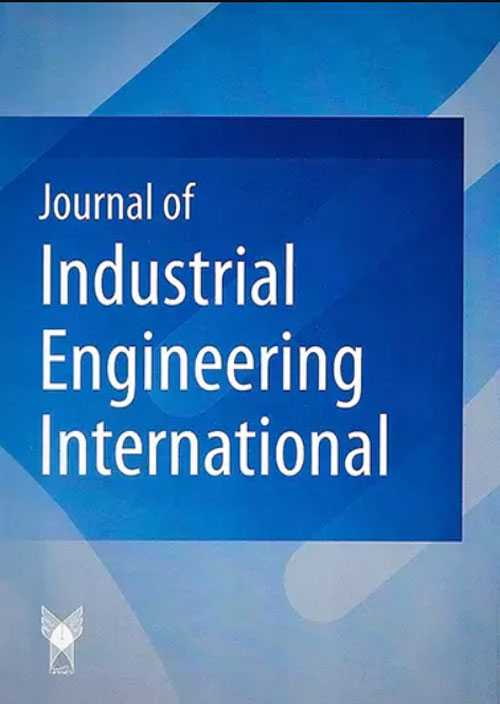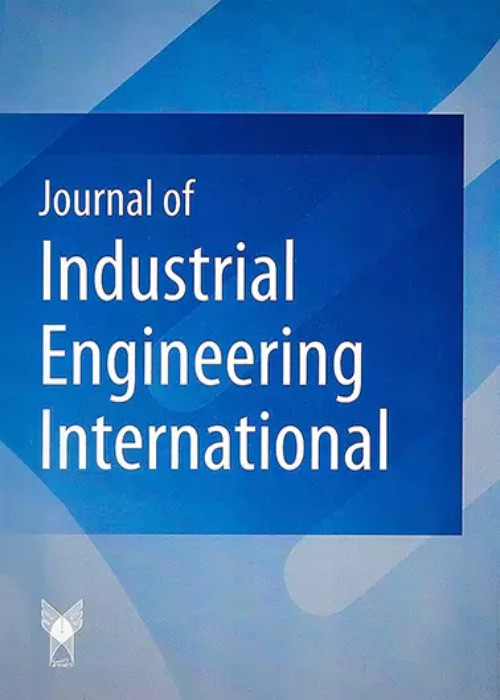فهرست مطالب

Journal Of Industrial Engineering International
Volume:17 Issue: 4, Autumn 2021
- تاریخ انتشار: 1401/07/23
- تعداد عناوین: 7
-
-
Pages 1-8
In predicting of failure time based on operating hours, after identifying the effective parameters on wear process, it’s of great importance to model an associated function between parameters and their effects on acceleration the failure. Gas turbines are too complicated to simple functions, proposed by manufacturer, cover all the possible scenarios with high confidence. In this article, all the parameters affected by time and the working cycle are combined by a relation with regarding a correction function that improve the accuracy of forecast to calculate equivalent working hours. The approach presented here, all the parameters, with a defined coefficient affect the failure process and lifetime reduction of the system and the various wear fractions within the exclusive temperature range are weighed by an appropriate factor. This method helps give a more realistic estimate of the residual life with more precision. The correction function will be updated consequently base on accurate of last output in compare with actual result. Looking at the data, we can observe that 90 percent of failures happen in the area between 7800 to 8100 hours of work, which indicate accuracy with regard to these values given for the parameters. Also result demonstrates that consideration of the last corrections in lifetime prediction is more effective than consideration of all the available data.
Keywords: Prognosis approach, wear pattern, Gas turbine, Failure time -
Pages 9-23
As global trade flourishes, terminals endeavor to get higher income while adapting to an expanded intricacy concerning terminal administration tasks. Perhaps the most common issues such terminals encounter is the Berth Allocation Problem (BAP), which involves allotting vessels to a bunch of berths and time allotments while at the same time limiting goals, for example, total stay time or total assignment cost. Complex formats of actual terminals present spatial constraints that restrict the mooring and departure of vessels. In spite of the fact that significant research has been carried out with regard to the BAP, these real-world limitations have not been considered in an overall manner. In this paper, a stochastic Multi-Period Berth Allocation-Scheduling Problem in Different Terminals with Irregular Layouts (SBAP) considering multi-Period modes, generalized precedence relations are developed. To solve the (SBAP), a solution approach based on Stochastic Chance Constraint Programming (SCCP) and a solution approach based on Two-Stage Stochastic Linear Programming with Recourse (TSSLPR) is proposed. A mathematical model is solved to show the applicability of the suggested model and solution approach.
Keywords: Berth Allocation Problem, Stochastic Programming, Multi-Period, Stochastic Optimization -
Pages 25-37
Aftermarket services need to track and trace their manufacturing processes and activities to eliminate untimely warranty claims. In this paper, we propose a system that allows manufactured products, including child components, to be traceable, which directly benefits the aftermarket service functions. A relation between a product and the components that are being manufactured is a prominent feature of the model. Identification processes are fundamental in order to establish the connection between physical products and digital means. A classification of item codes and a traceability model that describes and generates product identification is proposed. With parent-child relationships, all these inputs are automatically generated and deployed and consumed while generating a parent product order on the system ledger. The framework is linked with the existing ERP system and the design flow is prepared to integrate the framework to the practical production system. In the end, this results in complete product traceability throughout the product lifecycle.
Keywords: classification codes, inline, manufacturing, system integration, traceability -
Pages 39-52
In the organization of university units, the core of activities is the responsibility of faculty members and educational groups that are at the forefront of educational and research activities. Research performance impacts the sustainability and growth of the higher education system. The current study pursing the goal to represent the dimensions, components and indicators of creativity and initiative in order to evaluate the research performance of the faculty members of Tehran Islamic Azad University. The quantitative stage community consists of the experts of Tehran Islamic Azad University faculty members and 14 members of Higher Education, getting saturated with 10 ones. The qualitative stage data analysis was done using open coding, axial coding and selective coding with interviewing and Delphi technique. The qualitative stage induced results indicated the above dimensions and components consisting of nine dimensions, namely, research literacy, scientific factors, technical and information skills, methodological literacy, environmental factors, organizational factors, management factors, technological factors and personality traits. It is done this manner, in order to identify the dimensions, components and indicators of creativity and initiative, and the innovation of the research performance of the faculty members of the Islamic Azad University of Tehran, 9 dimensions, 25 components and 80 indicators were finally verified on the whole. The fuzzy Delphi analysis revealed that the experts had consensus on the detected dimensions, components and indicators. And the results displayed that the indicators of creativity and initiative are of personality traits components and included in the individual characteristics.
Keywords: Islamic Azad University Faculty Members, Evaluating Research Performance, PerformanceIndicators of Creativity, Initiative, Thematic Analysis, Fuzzy Delphi analysis -
Pages 53-74
Data uncertainty and multiple conflicting objectives are two crucial issues that the Decision Makers (DMs) must handle in making Aggregate Production Planning (APP) decisions in real practice. In order to address these two-mentioned issues, this study presents a multi-objective multi-product multi-period APP problem in an uncertain environment. The model strives to minimize the total costs of the APP plan, total changing rate in workforce levels, and total holding inventory and backorder quantities simultaneously through the Robust Possibilistic Chance-Constrained Programming (RPCCP) optimization approach. In this integrated approach, the RPCCP is applied for handling uncertain data. The RPCCP can not only handle any fuzzy position in the fuzzy model but also control the robustness of optimality and feasibility of the fuzzy model. Then, an Augmented Epsilon-Constraint (AUGMECON) technique is used to cope with multiple conflicting objectives. The AUGMECON technique can produce exact Pareto optimal solutions, which offer the DMs different selections to assess against conflicting objectives. Next, an industrial case study is provided to validate the applicability and effectiveness of the proposed methodology. The obtained outcomes indicate that the proposed RPCCP model outperforms the Possibilistic Chance-Constrained Programming (PCCP) model in terms of interested performance measurements (i.e., average and standard deviation of the objective function). In addition, a set of strong Pareto optimal solutions can be generated to accommodate alternative selections according to the DM’s preferences. Finally, by applying the Max-Min method, the best compromised (trade-off) solution is determined through a comparison among the attained Pareto solutions.
Keywords: Aggregate production planning, robust possibilistic programming, chance-constrained, credibilitymeasure, multiple-objective optimization, epsilon-constraint -
Pages 75-82
This study aims to develop an Economic Order Quantity (EOQ) model for agricultural products with a harvest period. These agricultural products can be stored for a long period, such as coffee and rice. The developed model assumes that the product can only be supplied during the harvest period while the demand is continuously increasing throughout the year. The harvest period only takes place once a year. During harvest, product orders are made to meet demand during harvest and storage to meet demand during non-harvest periods. The storage process will require a warehouse with sufficient capacity to accommodate the same number of products as demand in the non-harvest period. The developed model optimizes the order time interval with a minimum total inventory cost. Based on the optimization results, it can be calculated the frequency of orders, the quantity per one order, the minimum warehouse capacity that must be prepared, and the total cost of ordering per year. Based on sensitivity analysis, changes in harvest and non-harvest periods have a significant effect on total costs.
Keywords: Agricultural products, Economic order quantity (EOQ), inventories -
Pages 83-108
This investigation aims to demonstrate an application mathematical model of the sustainable closed-loop supply chain network (SCLSCN) during the COVID-19 pandemic. The suggested model can illustrate the trade-offs between environmental, economic, and social dimensions during the epidemic. The costs include the normal costs and the hygienic costs. The total cost was increased in the COVID-19 pandemic by 25.14 %. The novelty social aspects of this model include the average number of lost days caused by COVID-19 damage and the number of created new job opportunities related to COVID-19. The average number of lost days caused by damages increased by 51.64 % during COVID-19. The CO2 emissions were decreased by17.42 %. This paper presents a multi-objective mixed-integer programming (MOMIP) problem. We use the weighted sum method (WSM) approach for the scalarization approach. To optimize the process, Lingo software has been used. Our contributions to this research are i) Suggested an application model of SSC to show better the trade-offs between three aspects of sustainability in the COVID-19 pandemic and lockdown periods, ii) Designing the hygienic and safe SC for employees, iii) developing the social and economic indicators, iv) We have found the negative and positive impacts of COVID-19 and lockdowns on SC, v) Finally, we analyze the mathematical model and discuss managerial implications. Therefore, this investigation tries to fill this gap for COVID-19 condition disaster. This research's novelty is to simultaneously present a MOMIP model, COVID-19 issues, and hygienic rules, in a closed-loop supply chain (CLSC) framework.
Keywords: Sustainability, Closed-loop Supply Chain Network, COVID-19 Pandemic, Lockdowns, Multi-objectiveMixed-Integer Programming


